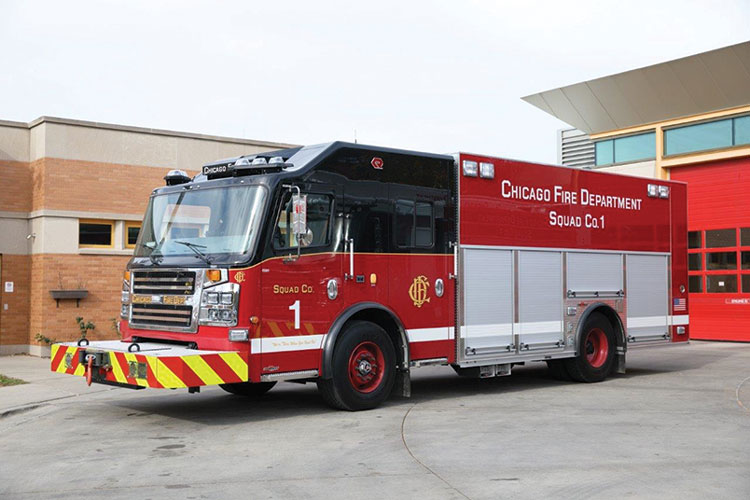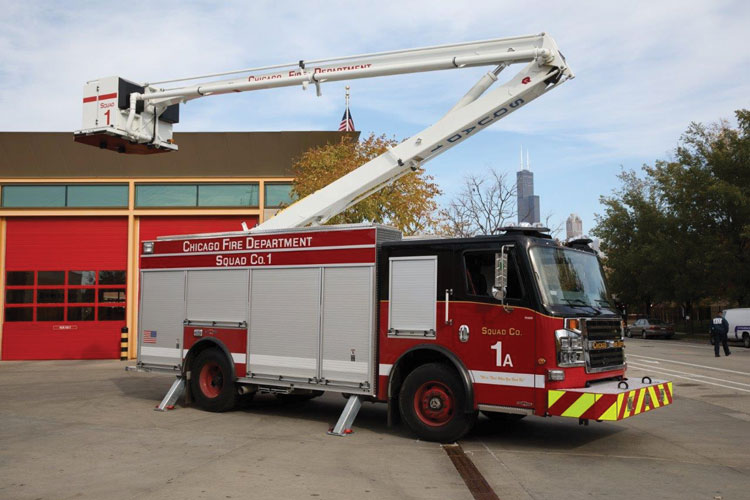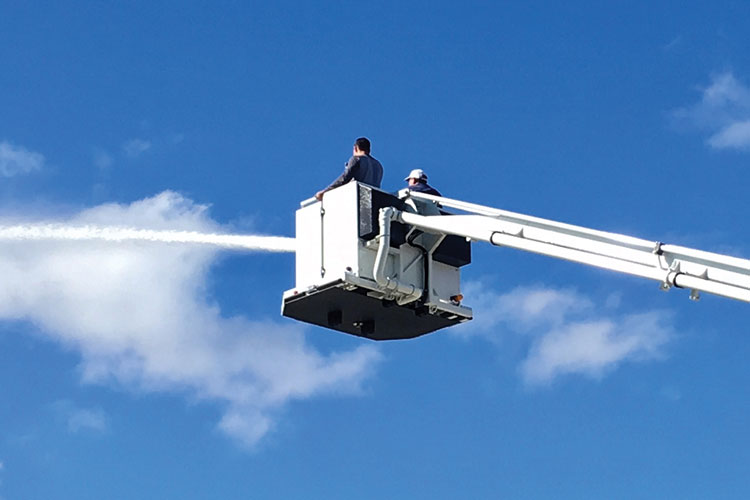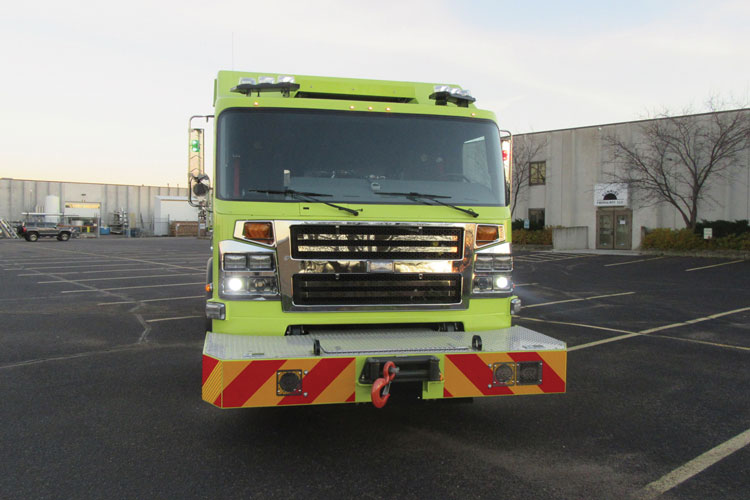
By Alan M. Petrillo
The Chicago (IL) Fire Department has taken delivery of eight custom rescue squads – four walk-through models and four squads carrying Rosenbauer ACP-55 articulating Cobra platforms.
Three of the ACP-55 equipped rescues and three of the walk-through squads are located in Chicago’s north, central, and south divisions, while one ACP-55 rescue and one walk-through squad are located at Chicago’s O’Hare International Airport.
Chicago Squad Concept
Paul T. Foertsch, district chief for the Bureau of Logistics in the Chicago Fire Department, says the two types of rescue squads respond together on all alarms, never separately. “The ACP-55 squad travels with two special operations firefighters, and the walk-through travels with four,” Foertsch says. “The squads are our elite special operations companies and carry all our heavy rescue equipment. Members are selected through a special interview process and then go through special operations certification.”
 |
| 1 The Chicago (IL) Fire Department has taken delivery of four Rosenbauer custom walk-through rescue squads and four custom rescue squads outfitted with Rosenbauer’s ACP-55 articulating Cobra platform. (Photos courtesy of Rosenbauer unless otherwise noted.) |
Roger Parker, northern regional sales manager for Rosenbauer, says the ACP-55 units on the Chicago rescue squads are the first ones deployed in such a fashion by the company. “The ACP-55 uses a single joystick control with Smart Aerial technology that includes auto bedding, collision avoidance, soft touch ramp up and ramp down, and high- and low-range speeds,” Parker points out. “Diagnostic screens are located in the bucket and at the pedestal.”
Foertsch notes that the Chicago Fire Department has had aerial units on its rescue squads since the 1960s. “The new Rosenbauer ACP-55s are replacing 15-year-old 55-foot Snorkel units,” he says. “The ACP-55 units are a little bit bigger physically than what we had, but we gained more compartment space and platform space on the new ones.”
Parker adds that Chicago’s previous Snorkel rescue squads were built by Central States in 2000, a company that was purchased by Rosenbauer.
 |
| 2 The Rosenbauer walk-through rescues each seat four firefighters in the cab and allow access to the interior of the rear of the body both from the cabs and through a rear door. |
The New Squads
All eight of the rescue squads are built on Rosenbauer’s Commander chassis and EXT body, with the ACP-55 units having flat roofs and the walk-through squads having 18-inch raised roofs. They have a wheelbase of 170 inches, are 29 feet 8 inches long, are 10 feet 7 inches high, are on single rear axles, and are powered by Cummins ISX12 425-horsepower (hp) diesel engines and Allison 4000 EVS automatic transmissions.
Each ACP-55 rescue squad has a two-firefighter cab to allow for a transverse compartment behind the cab that carries a Zodiac inflatable boat and outboard motor. Foertsch points out the Zodiacs are deployed on Chicago’s inner city lagoons for water rescue, while Chicago’s fire boats and fast rescue boats handle water rescues on rivers and Lake Michigan.
 |
| 3 Each ACP-55-outfitted rescue has seating for two crew members and a transverse compartment behind the cab that carries a Zodiac inflatable boat and outboard motor used by the department for water rescues on the city’s inner city lagoons. |
Breathing air is provided at the tip of the ACP-55 aerial, as is a Task Force Tips Typhoon 1,250-gallon-per-minute (gpm) monitor and nozzle and two Whelen Micro Pioneer LED lights. The aerial is stabilized by four A-style outriggers (two at the rear and two at the center of the truck). Tip load is 750 pounds dry and 500 pounds wet.
The walk-through rescue squads have seating for four firefighters, who can access the back of the truck through interior walkways that feature interior storage on both sides. The walk-throughs also can be accessed through rear doors. Foertsch says that the walk-through rescues are equipped differently from the ACP-55 rescues. “They carry our Hurst eDRAULIC tools, our scuba gear, meters, and specialized high-rise equipment and subway equipment,” he says. “We wanted as much compartment space as possible on our squads, and they include electrical outlets to plug in meters and other equipment so they can be charged both on the road and in the firehouse.”
 |
| 4 The aerial on the ACP-55 each rescue squad uses has a single joystick control with Smart Aerial technology that includes auto bedding, collision avoidance, soft touch ramp up and ramp down, and high- and low-range speeds. |
Parker says that the eight rescue squads have extreme-duty front bumpers, ROM roll-up doors, SlideMaster trays and tool boards, Turtle Tile on all shelves and trays, Onan 20-kW generators, Federal Signal Quadra Flare warning lights, and Kussmaul battery chargers. The four walk-through rescue squads each have a Ramsey 25,000-ton hydraulic winch fitted in the front bumper.
Department Reception
Foertsch says, “Rosenbauer was great to work with and builds a wonderful product. The rescue squads got good reviews from our members. And, we were able to make a couple of small modifications based on what our members saw during their training with the squads by Rosenbauer.”
He adds, “We are very impressed with these squads and their operation. Our squad special operations fleet just got a big boost with these rigs. It was a long time waiting, but the members are very pleased with what Rosenbauer has delivered and especially like the auto bedding feature.”
 |
| 5 The platform on each ACP-55 model rescue squad carries a Task Force Tips Typhoon 1,250-gpm monitor and nozzle and two Whelen Micro Pioneer LED lights and is provided with breathing air. (Photo courtesy of the Chicago Fire Department.) |
Parker points out that the Chicago Fire Department wanted to be able to carry all the rescue tools and equipment it needed on the two different style trucks. “Every inch of area on those trucks has equipment on them,” he says. “They used up all the available space.”
ALAN M. PETRILLO is a Tucson, Arizona-based journalist, the author of three novels and five nonfiction books, and a member of the Fire Apparatus & Emergency Equipment editorial advisory board. He served 22 years with the Verdoy (NY) Fire Department, including in the position of chief.
department
 |
| 6 Four A-style outriggers, two in the center of the truck and two at the rear, support the ACP-55 rescue squads when the aerials are raised. |
specs
Rosenbauer ACP-55 Rescue for Chicago (IL) Fire Department
- Rosenbauer Commander chassis and EXT bodies
- 3⁄16-inch aluminum 100-inch-wide 19-foot rescue bodies
- 170-inch wheelbases
- 29-foot 8-inch overall lengths
- 10-foot 7-inch overall heights
- Single rear axles
- Extreme-duty front bumpers
- ROM roll-up doors
- Slidemaster trays
- Turtle Tile on all shelves and trays
- Cummins 425-horsepower ISX12 diesel engines
- Allison 4000 EVS automatic transmissions
- 55-foot articulating Cobra platforms
- Breathing air at aerials
- Four A-style outriggers on each
- Task Force Tips Typhoon 1,250-gpm monitor and nozzle
- Two Whelen Micro Pioneer LED lights on each platform
- Rosenbauer Smart Aerial technology
- Tip loads of 750 pounds dry, 500 pounds wet
- Onan 20-kW generators
- Federal Signal Quadra Flare warning lights
- Kussmaul battery chargers
 |
| 7 The two Rosenbauer rescues detailed to protect O’Hare International Airport are duplicates of those rescue squads protecting the north, central, and south sections of the city but are a different color. Shown is the O’Hare walk-through rescue squad. |
specs
Rosenbauer Walk-In Rescues
- Rosenbauer Commander chassis and EXT bodies with 18-inch raised roofs
- 3⁄16-inch aluminum, 100-inch-wide, 19-foot rescue bodies
- 170-inch wheelbases
- 29-foot 8-inch overall lengths
- 10-foot 7-inch overall heights
- Single rear axles
- Extreme-duty front bumpers
- Ramsey 25,000-ton hydraulic winches
- ROM roll-up doors
- Slidemaster trays
- Turtle Tile on all shelves and trays
- Cummins 425-hp ISX12 diesel engines
- Allison 4000 EVS automatic transmissions
- Onan 20-kW generators
- Federal Signal Quadra Flare warning lights
- Kussmaul battery chargers
 |
| 8 The interior of each walk-through rescue squad, where additional equipment is stowed, can be accessed through a rear door or from the body of the cab. |

